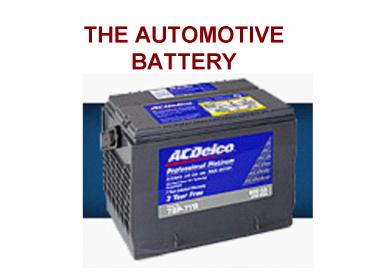THE AUTOMOTIVE BATTERY - PowerPoint PPT Presentation
1 / 16
Title:
THE AUTOMOTIVE BATTERY
Description:
THE AUTOMOTIVE BATTERY What is the purpose of the battery in a car? Provide voltage and current for the starter motor Provide voltage and current for the ignition ... – PowerPoint PPT presentation
Number of Views:1118
Avg rating:3.0/5.0
Title: THE AUTOMOTIVE BATTERY
1
THE AUTOMOTIVE BATTERY
2
What is the purpose of the battery in a car?
- Provide voltage and current for the starter motor
- Provide voltage and current for the ignition
system during cranking - Supplies all electrical power when the charging
system is not operating - Acts as a voltage stabilizer for the charging
system - Provides extra current for short periods of time
while the charging system is catching up to a new
load
3
BATTERY OPERATION
- The automotive battery is an electrochemical
device that provides a potential difference. - Automotive batteries are made up of a series of
secondary cells that can be recharged. - The battery does not store electrical energy, it
stores chemical energy that is converted to
electrical energy as it discharges.
4
What is needed for an
electrochemical reaction to occur?
- Two unlike metals in a conductive and reactive
solution (electrolyte) - A battery cell is made up of spongy lead, lead
peroxide and an electrolyte of sulfuric acid and
water. - This kind of battery is called a lead-acid
battery. - The spongy lead (Pb) is the negative material.
- The lead peroxide (PbO2) is the positive
material. - The electrolyte is 64 water (H2O) and 36
sulfuric acid (H2SO4) when the battery is fully
charged.
5
The Discharge Charge Process
- As the battery discharges, a chemical reaction
occurs which releases electrons from the lead
(Pb) and causes the lead peroxide (PbO2) to gain
electrons. - During this process both of the materials are
changing to lead sulfate (PbSO4) and the
electrolytes acid is changing to water (H2O). - As the battery is recharged the reaction is
reversed and the materials and electrolyte return
to their original states.
6
The process of discharging and recharging
is called cycling.
- Discharging Reaction
- Pb H2SO4 Þ PbSO4 H2 2 electrons
- PbO2 H2SO4 2 electrons Þ PbSO4 H2O O2
- Recharging Reaction
- PbSO4 2 electrons H2 Þ Pb H2SO4
- PbSO4 (-2 electrons) H2O O2 Þ PbO2 H2SO4
7
Voltage
- Each battery cell produces 2.1v during the
discharge reaction. - Cells are connected in series to gain the desired
battery voltage. - 3 cells yield 6.3v
- 6 cells yield 12.6v
- Charging voltage needs to be 1 volt or more above
battery voltage to reverse the reaction.
8
Battery Construction
- Cells are made of positive and negative plates
which are kept from touching by a porous
separator material, usually plastic or
fiberglass. - The plates are made on a lead alloy grid which
holds the spongy lead or lead peroxide material. - The positive grids are connected together with a
post strap. The negative grids are also
connected together. The grids carry the cell
current to the battery posts. - The battery case is divided into cell cavities
which hold the electrolyte and the plate groups.
The plate group from one cell is connected to
another cells plate group through a hole in the
cell wall.
9
(No Transcript)
10
Battery Varieties
- Cycling Battery
- Designed to produce low current for long periods
of time. - They are usually very discharged before
recharging. - Plate material is thicker than an automotive
battery. - Starting Battery
- Designed to produce high current for very short
periods of time. - There is usually only a slight discharge before
recharging. - Plate material is thinner to reduce heat
generation.
11
Battery Types
- 1. Non-maintenance Free -
- Lead-antimony grid
- Removable vent caps use to inspect electrolyte
and add water. - 2. Low-maintenance -
- Hidden vent caps
- Lead - calcium or Lead - strontium grid which
lowers electrical resistance and heat generation.
This reduces gassing and electrolyte loss.
12
Battery Types
- 3. Maintenance Free -
- No vent caps. The case has small vents at both
ends. - Grid similar to low-maintenance
- Envelope type separators keep loose plate
material near plates
13
Battery Types
- 4. Hybrid
- Lead - antimony in positive grid,
- Lead - calcium in negative grid reduces gassing
and internal corrosion - Spun glass separators allow for a more efficient
chemical reaction - These batteries are able to withstand more deep
cycling
14
Battery Types
- 5. Recombinant
- No caps or vents
- Gel type electrolyte
- Special envelope type separators allow hydrogen
gas to be reabsorbed. No gassing - Generate 13.2 volts with six cells
15
Grid Types
- 1. Square Grid
- The grid frame is a pattern of squares or
rectangles. - Longer current path, high resistance
- 2. Diagonal Grid
- The vertical grid bars are set at diagonals to
shorten the current path and lower resistance
16
End Lesson One































